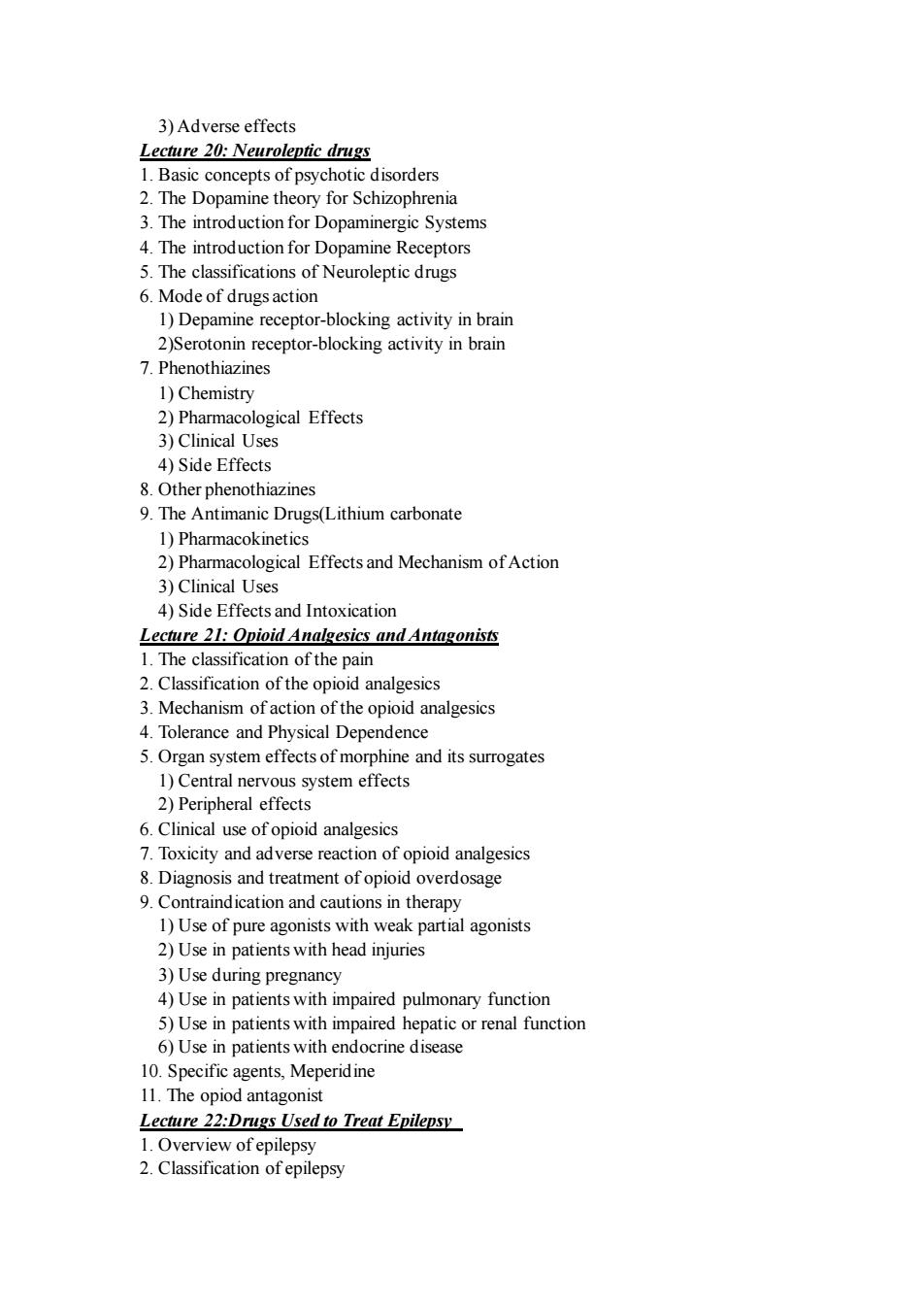
2)Fate of Administered L-dopa 3)Ther 5)Drug Interactions 6)Contraindications 6.Specific Agents 1)Dopa nine Ago nists:Bromocriptine 2)M inhib tors:ra 1-O-Methyl Transferase Inhibitors:tolcapone and entacapone 4)Anticholinergic Drugs Lecture 18:Anxiolytic and Hypnotic Drugs 1.Definition of Sedativesand Hypnotics ses of sleep zodiazepine Diazepam 1)Classification 2)Pharmacokinetics 3)Mechanism of benzodiazepines 4)Therapeutie Uses 5)Adverse Effect 6)Tolerance and Dependence 7)Drug Interactions 8)Characteristics of different drugs 4.Benzodiazepines Antagonist- --Flumazenil 1)Classification 2)Pharmacokinetics 3)Mechanism of benzodiazepines 4)Therapeutic Uses 5)Adv 6.Other Sedative-Hypnotics Lecture 19:Antidepressants drugs 1.The classification of affective disorders(Mania,depression) 2.the mechanism of depression 1)Monoamine theory of depression 2)The other theory of depression 3.Tricyclic Antidepressants 1)Pharmacologic effects and mechanism of action 2)Clinical uses 3)Side effects Tetracyclic 4.Selective 5-HT R 6.Treatment of bipolar affective disorders(BPAD)Lithium 1)Mechanism of action 2)Indictions
2) Fate of Administered L-dopa 3) Therapeutic Uses 4) Adverse Effects 5) Drug Interactions 6) Contraindications 6. Specific Agents 1) Dopamine Agonists : Bromocriptine 2) Monoamine oxidase inhibitors: rasagiline 3) Catechol-O-Methyl Transferase Inhibitors :tolcapone and entacapone 4) Anticholinergic Drugs Lecture 18: Anxiolytic and Hypnotic Drugs 1. Definition of Sedatives and Hypnotics 2. Two phases of sleep 3. Benzodiazepines----------Diazepam 1) Classification 2) Pharmacokinetics 3) Mechanism of benzodiazepines 4) Therapeutic Uses 5) Adverse Effects 6) Tolerance and Dependence 7) Drug Interactions 8) Characteristics of different drugs 4. Benzodiazepines Antagonist -----------Flumazenil 5. Barbiturates 1) Classification 2) Pharmacokinetics 3) Mechanism of benzodiazepines 4) Therapeutic Uses 5) Adverse Effects 6. Other Sedative-Hypnotics Lecture 19: Antidepressants drugs 1. The classification of affective disorders(Mania,depression) 2. the mechanism of depression 1) Monoamine theory of depression 2) The other theory of depression 3. Tricyclic Antidepressants 1) Pharmacologic effects and mechanism of action 2) Clinical uses 3) Side effects Tetracyclic 4. Selective 5-HT Reuptake Inhibitors 5. Selective MAO-A inhibitor 6. Treatment of bipolar affective disorders (BPAD)Lithium 1) Mechanism of action 2) Indictions

3)Adverse effects Lecture 20:Neuroleptic drugs 1.Basic concepts of psychotic disorders 2.The Dopamine theory for Schizophrenia 3.The introduction for Dopaminergic Systems 4.The introduction for Dopamine Receptors 5.The classification of Neuroleptic drugs 6 Mode of drugsaction 1)Depamine receptor-blocking activity in brair 2)Serotonin receptor-blocking activity in brain 7 Phenothiazines 1)Chemistry ogical Effects 3)Clinical Uses 4)Side Effects 8.Other phenothiazines 9.The Antimanic Drugs(Lithium carbonate 1)Pharma okin 2)Pharmac logical Effects and Mechanism ofAction 3)Clinical Uses 4)Side Effects and Intoxication Lecture 21:Opioid analgesics and antagonists 1.The classification of the 2.Clas sification of the opioid analgesics 3.Mechanism of action of the opioid analgesics 4 Tolerance and physical dependence 5.Organ system effects of morphine and its surrogates 1)Central ne system effects 2)Peripheral 6.Clinical use of opioid analgesics 7.Toxicity and adverse reaction of opioid analgesics 8.Diagnosis and treatment of opioid overdosage 9.Contraindication and cautions 1)Use of pu s in therapy nist uith woak ial agonists 2)Use in patients with head injuries 3)Use during pregnancy 4)Use in patients with impaired pulmonary function 5)Use in patients with impaired hepatic or renal function 6)Use in atients with endoc 10.Specific agents,Meperidine 11.The opiod antagonist Lecture 22:Drugs Used to treat epilepsy 1.Overview of epilepsy 2 Classification ofe epsy
3) Adverse effects Lecture 20: Neuroleptic drugs 1. Basic concepts of psychotic disorders 2. The Dopamine theory for Schizophrenia 3. The introduction for Dopaminergic Systems 4. The introduction for Dopamine Receptors 5. The classifications of Neuroleptic drugs 6. Mode of drugs action 1) Depamine receptor-blocking activity in brain 2)Serotonin receptor-blocking activity in brain 7. Phenothiazines 1) Chemistry 2) Pharmacological Effects 3) Clinical Uses 4) Side Effects 8. Other phenothiazines 9. The Antimanic Drugs(Lithium carbonate 1) Pharmacokinetics 2) Pharmacological Effects and Mechanism of Action 3) Clinical Uses 4) Side Effects and Intoxication Lecture 21: Opioid Analgesics and Antagonists 1. The classification of the pain 2. Classification of the opioid analgesics 3. Mechanism of action of the opioid analgesics 4. Tolerance and Physical Dependence 5. Organ system effects of morphine and its surrogates 1) Central nervous system effects 2) Peripheral effects 6. Clinical use of opioid analgesics 7. Toxicity and adverse reaction of opioid analgesics 8. Diagnosis and treatment of opioid overdosage 9. Contraindication and cautions in therapy 1) Use of pure agonists with weak partial agonists 2) Use in patients with head injuries 3) Use during pregnancy 4) Use in patients with impaired pulmonary function 5) Use in patients with impaired hepatic or renal function 6) Use in patients with endocrine disease 10. Specific agents, Meperidine 11. The opiod antagonist Lecture 22:Drugs Used to Treat Epilepsy 1. Overview of epilepsy 2. Classification of epilepsy